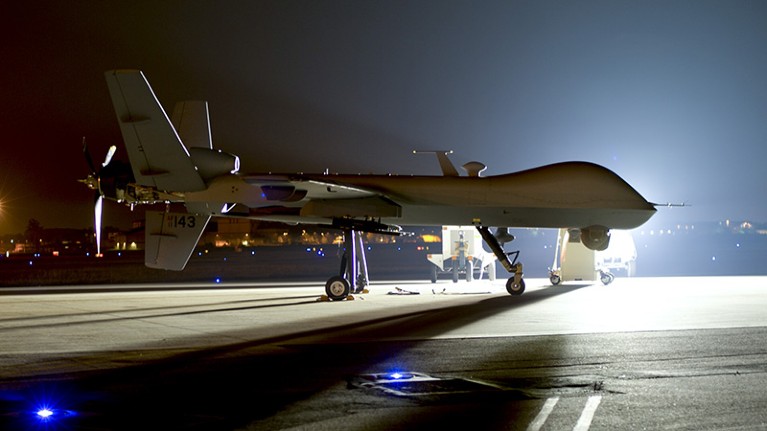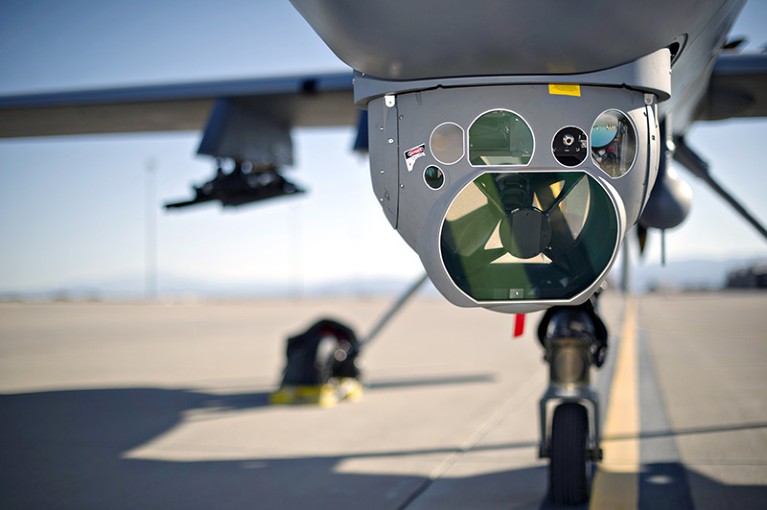
An MQ-9 Reaper drone, used for surveillance by the US Air Force.Credit: Staff Sgt. John Bainter/U.S. Air Force
Eyes in the Sky: The Secret Rise of Gorgon Stare and How It Will Watch Us All Arthur Holland Michel Houghton Mifflin Harcourt (2019)
In the 1998 Hollywood thriller Enemy of the State, an innocent man (played by Will Smith) is pursued by a rogue spy agency that uses the advanced satellite “Big Daddy” to monitor his every move. The film — released 15 years before Edward Snowden blew the whistle on a global surveillance complex — has achieved a cult following.
It was, however, much more than just prescient: it was also an inspiration, even a blueprint, for one of the most powerful surveillance technologies ever created. So contends technology writer and researcher Arthur Holland Michel in his compelling book Eyes in the Sky. He notes that a researcher (unnamed) at the Lawrence Livermore National Laboratory in California who saw the movie at its debut decided to “explore — theoretically, at first — how emerging digital-imaging technology could be affixed to a satellite” to craft something like Big Daddy, despite the “nightmare scenario” it unleashes in the film. Holland Michel repeatedly notes this contradiction between military scientists’ good intentions and a technology based on a dystopian Hollywood plot.
Governments want your smart devices to have stupid security flaws
He traces the development of that technology, called wide-area motion imagery (WAMI, pronounced ‘whammy’), by the US military from 2001. A camera on steroids, WAMI can capture images of large areas, in some cases an entire city. The technology got its big break after 2003, in the chaotic period following the US-led invasion of Iraq, where home-made bombs — improvised explosive devices (IEDs) — became the leading killer of US and coalition troops. Defence officials began to call for a Manhattan Project to spot and tackle the devices.
In 2006, the cinematically inspired research was picked up by DARPA, the Defense Advanced Research Projects Agency, which is tasked with US military innovation (D. Kaiser Nature 543, 176–177; 2017). DARPA funded the building of an aircraft-mounted camera with a capacity of almost two billion pixels. The Air Force had dubbed the project Gorgon Stare, after the monsters of penetrating gaze from classical Greek mythology, whose horrifying appearance turned observers to stone. (DARPA called its programme Argus, after another mythical creature: a giant with 100 eyes.)
Some books use blockbuster action films to demonstrate — or exaggerate — a technology’s terrifying potential. Here, Enemy of the State shows up repeatedly because it is integral to the development of Gorgon Stare. Researchers play clips from it in their briefings; they compare their technology to Big Daddy (although their camera is so far only on aircraft, not a satellite). At one point, incredibly, they consult the company responsible for the movie’s aerial filming. (It set me wondering — which government lab out there is currently building the Death Star from Stars Wars?)

A camera on an MQ-9 Reaper drone.Credit: A1c Aaron Montoya/Planet Pix via ZUMA
Holland Michel’s book is not the first to look at technologies intended to achieve omniscience, but it is among the best. Writers examining the intersection of technology and privacy often repeat well-worn tropes, claiming that every novelty is the new Big Brother. But Eyes in the Sky is that rare creature: a deeply reported and deftly written investigation that seeks to understand both the implications of a technology and the motivations of its creators. Holland Michel notes tensions between security and privacy without hyping them.
And he gets those responsible for building WAMI to speak to him candidly — sometimes shockingly so. Take, for example, the former US military officer who touts the ‘benefits’ of the colonial subjugation of India (which he bizarrely claims created order among the country’s ethnic groups) to justify mass surveillance in the United States.
This potential for domestic mass surveillance becomes a key point. As the story proceeds, WAMI’s creators start looking for ways to use the battlefield technology at home: having built a new hammer, they search for more nails. Here, the story takes an even more dystopian turn. John Arnold, “a media-shy billionaire”, uses his own money to help secretly deploy a WAMI system to assist the police in tracking suspects in crime-ridden Baltimore, Maryland. Arnold, who has funded other “new crime-fighting technologies”, first learnt about WAMI’s use overseas from a podcast, and decided to debut it stateside. “Even the mayor was kept in the dark,” Holland Michel writes.
Private interests
Is this our future? A world in which billionaires fund the police to record entire cities from above? That plot twist is less Enemy of the State than Batman, although it’s hard to know who the hero is. (At least the fictional Big Daddy was funded by Congress, even if its supporters had to kill one stubborn lawmaker to get the job done.) It’s enough to make us all reach for tinfoil hats, which could come in handy to block what Holland Michel warns is coming next: infrared imaging that can detect people inside their homes. WAMI, if deployed above your city, already has the capacity to track your daily commute and errands, and allow those watching to retrace your steps for days or weeks.
Dreaming of death rays: the search for laser weapons
To his credit, Holland Michel’s interviews with surveillance technologists are reported with context but without commentary, allowing readers to draw their own conclusions. In one understated episode, he reveals that — after the Baltimore project was exposed — the owner of the company that built and deployed the WAMI system there had “personally” provided gifts to a community organizer. The organizer was working to convince Baltimore residents that a sky-borne Big Brother might be in their interests.
One unanswered, and perhaps unanswerable, question is how successful WAMI was at its original purpose: preventing insurgent bomb attacks in Iraq and Afghanistan. Holland Michel isn’t sure, because the answer is classified. Although investment in WAMI is “furious and ongoing”, he notes, “the Air Force declined repeated requests for even an approximate indication of WAMI’s impact on the battlefield”.
What we do know is that Afghanistan, one of the most surveilled countries on Earth, is slipping further into chaos. That can’t be blamed on WAMI, but it does indicate that the tech is not today’s Manhattan Project.
The long entanglement of war and astrophysics
There are other questions. By focusing on a specific technology, does Holland Michel miss a bigger picture? Is the more serious threat the access of governments and corporations to our electronic devices? The answer to both is no, because he also traces how meshing WAMI with other sensors, including those on smartphones, will eventually create “a fully fused city” where “there may be nowhere to hide”. In the end, Eyes in the Sky transcends its title by using Gorgon Stare as a window into our future. And that is bleak.
When Gorgon Stare is completed, Michael Meermans, an executive at Sierra Nevada (the company in Sparks, Nevada, that built it) asks himself rhetorically whether the task is over. Of course not. “When it comes to the world of actually collecting information and creating knowledge,” Meermans says, “you can never stop.”


 Dreaming of death rays: the search for laser weapons
Dreaming of death rays: the search for laser weapons
 The long entanglement of war and astrophysics
The long entanglement of war and astrophysics
 Governments want your smart devices to have stupid security flaws
Governments want your smart devices to have stupid security flaws
 Masters of war
Masters of war








